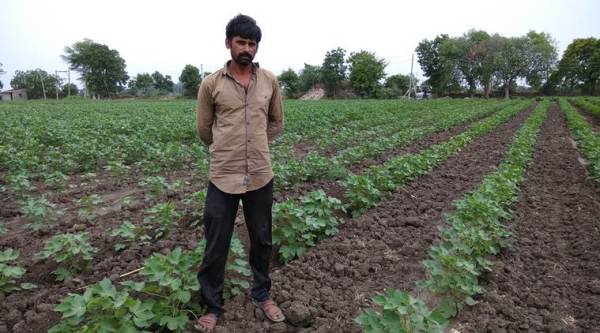- India
- International
White Gold: Gujarat farmers put all their eggs in cotton basket
The ongoing US-China trade tensions may lead to increase in demand for Indian cotton overseas. If exports go up, prices will harden in the domestic market.
 Farmer Dhiru Rajput in his cotton field in Chuli village of Surendranagar. (Express Photo/Gopal Kateshiya)
Farmer Dhiru Rajput in his cotton field in Chuli village of Surendranagar. (Express Photo/Gopal Kateshiya)
“You can see these dhefa (sun-baked hardened lumps of soil) and understand how little it has rained. One good rain can melt them, but we are still waiting for that shower in this monsoon season,” remarks Dhiru Rajput, as he surveys the swaying cotton crop on his 1.25-hectare field adjoining State Highway 7 in Chuli village of Surendranagar district’s Dhrangadhra taluka.
The 32-year-old is, however, among the few lucky farmers in Surendranagar and neighbouring Morbi district having access to groundwater. It has enabled them to plant their favourite crop — cotton — despite scanty rains in July, with hardly a week left of what is normally the year’s wettest month. The dhefa notwithstanding, Rajput believes that his late-May sown crop looks good enough to yield over 40 quintals of kapas (un-ginned seed cotton) per hectare. “There’s enough water in my bore-well to irrigate this crop. I’m praying for rains only because it will reduce my electricity bill,” he explains.
Rajput owns 11 hectares in all, comprising four fields including the one next to the state highway. His second plot of four hectares – which he has given to a share-cropper who retains 28 per cent of the harvested produce — also has a bore-well. “I wanted him (the share-cropper) to grow castor, but he has also ended up planting cotton on two hectares”, notes Rajput, whose other two fields are rain-fed, in which he mainly cultivates jowar (sorghum) fodder for his three cows and three buffaloes.
Last year, Rajput could harvest only 30 quintals of kapas from his 1.25-hectare field, because of too much rain, in contrast to this time’s. But his average realisation of Rs 5,000 per quintal was more than the Centre’s minimum support price (MSP) of Rs 4,320 for long-staple varieties. “This land is ideal for cotton. After harvesting (over three pickings from early-October to end-December), I can also take jeera (cumin seed) and onion during the winter season,” he points out.
Shivraj Khachar of Gosal village in Surendranagar’s Sayla taluka, too, has opted to sow cotton in his entire three-hectare holding. For him, though, there’s little choice, as the 100-feet-deep open well in his field cannot supply water beyond early-November. “If I grow groundnut (which has a shorter 100-120 days duration, as against 180-200 days for cotton), there is not enough water left for a second winter crop. I can, then, only plant a single crop of cotton,” he says.

Khachar was able to harvest only 40 quintals from his three hectares last year, thanks to a gulabi eyal (pink bollworm) attack late in the season. He also got an average rate of just Rs 4,250 per quintal. “I have only limited holding capacity and cannot wait for prices to rise. My hope this time is that there will be no gulabi eyal and prices, too, are better,” adds the 30-year-old, who is aware that the Narendra Modi government has raised the MSP for this year’s cotton crop to Rs 5,450 per quintal, but not sure about realising that price.
Gujarat – India’s top cotton producing state and No. 2 in acreage behind Maharashtra – has seen 21.84 lakh hectares (lh) area being planted under the fibre crop as on July 24, compared to the 25.84 lh in the corresponding period of 2017. The Saurashtra region, which is the state’s main cotton belt, has recorded a drop in sown area from 18.43 lh to 15.29 lh. Within Saurashtra, the progressive acreage has fallen sharply in Surendranagar (from 3.90 lh to 2.56 lh) and Morbi (from 1.98 lh to 1.04 lh), while rising in Amreli (from 3.74 lh to 4.01 lh) and Bhavnagar (from 2.11 lh to 2.15 lh) and declining marginally in Rajkot (from 2.38 lh to 2.21 lh) and Botad (from 1.67 lh to 1.59 lh).
While Amreli, Bhavnagar, Rajkot and Botad districts have received very good rains in the current monsoon season, this has not been so for Surendranagar and Morbi. Dhrangadhra taluka, to which Rajput’s village belongs, has received barely 10 millimeters (mm) rain since June 1 – less than two per cent of its 534 mm annual average precipitation. Likewise, Halvad and Maliya talukas of Morbi have so far recorded only 57 mm (12 per cent of average) and 77 mm (16 per cent), respectively. And these happen to be major cotton-growing areas.
In many villages of Halvad and Maliya bordering the Little Rann of Kutch, where the groundwater is salty and hence not suitable for irrigation, it is only the release of the Narmada River waters from the Maliya Branch Canal about two weeks ago that has enabled farmers like Amrutlal Bhoraniya to even take up sowing.
“We could only have gone for cotton. Last year, groundnut prices weren’t good and the crop is, moreover, susceptible to raiding by nilgai (blue bull), wild boars and wild asses (for whom the Little Rann is a sanctuary). Last year, I harvested an average kapas yield of 37 quintals per hectare over three picking and also grew jeera and wheat in the winter season. This time, given the delayed sowing, I may be able to grow just a fodder crop after cotton,” admits Bhoraniya, who, along with his two brothers, farms nine hectares in Dhulkot village of Halvad.
While cotton acreage may eventually reach its normal average, farmers have not been very keen to grow groundnut, the second most important cash crop of Gujarat. This, in spite of good rainfall in the main groundnut belt of Saurashtra spread across Junagadh, Gir Somnath, Porbandar, Devbhumi Dwarka, Bhavnagar and Rajkot districts. As on July 24, groundnut acreage in Gujarat was only 11.30 lh, against 16.02 lh during the same period last year. In 2017-18, the state produced a record 32 lakh tonnes crop, resulting in prices crashing well below the MSP of Rs 4,500 per quintal, inclusive of the Gujarat government’s Rs 50 bonus. The oilseed is now selling at around Rs 3,500 per quintal, despite the Centre announcing a further MSP hike for the 2018-19 crop to Rs 4,890 per quintal.
According to traders, the price outlook for cotton is bullish. India produced 36.5 lakh bales (lb) of cotton in 2017-18. The Cotton Association of India has projected closing stocks for the year ended September 30, 2018 at 22 lb, lower than the previous year’s level of 36.07 lb. “The carry-forward for the new season is low and the ongoing US-China trade tensions may lead to further increase in demand for Indian cotton overseas. If exports (estimated at 58.21 lb in 2016-17 and 70 lb in 2017-18) go up, prices will obviously harden in the domestic market,” observes Sagar Patel, proprietor of Ambica Cotton Industries, a ginning factory in Godavari village of Surendranagar’s Muli taluka.
The benchmark global Cotlook ‘A’ Index price is currently ruling at around 97 cents per pound, more than the 84.5 cents a year ago. Anand Popat of Cotyarn Tradelink LLP, a Rajkot-based cotton brokerage firm, believes that kapas prices will range above the MSP in the coming cotton marketing year from October. That should be good news to cotton growers — and not bad at all for the ruling BJP ahead of the 2019 national elections.
Apr 26: Latest News
- 01
- 02
- 03
- 04
- 05








































